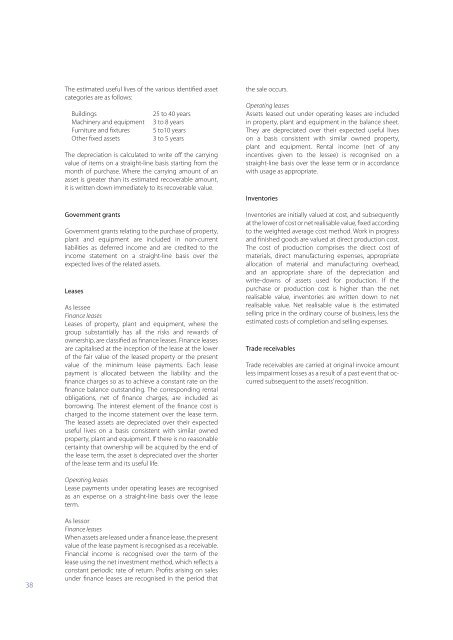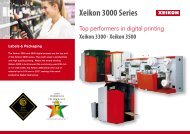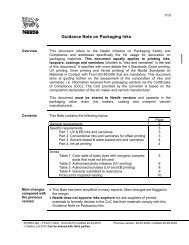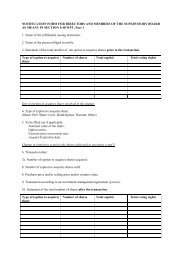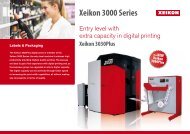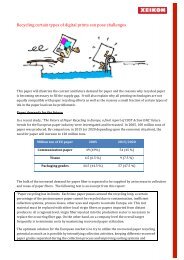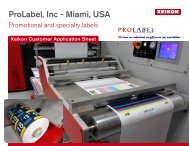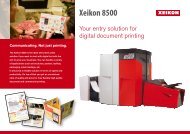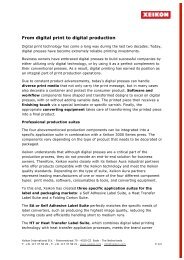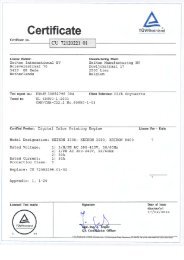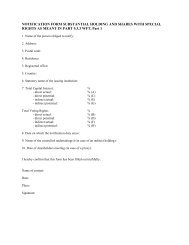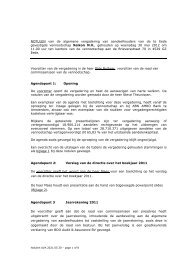Annual report 2005 - Xeikon
Annual report 2005 - Xeikon
Annual report 2005 - Xeikon
You also want an ePaper? Increase the reach of your titles
YUMPU automatically turns print PDFs into web optimized ePapers that Google loves.
The estimated useful lives of the various identified asset<br />
categories are as follows:<br />
Buildings<br />
Machinery and equipment<br />
Furniture and fixtures<br />
Other fixed assets<br />
25 to 40 years<br />
3 to 8 years<br />
5 to10 years<br />
3 to 5 years<br />
The depreciation is calculated to write off the carrying<br />
value of items on a straight-line basis starting from the<br />
month of purchase. Where the carrying amount of an<br />
asset is greater than its estimated recoverable amount,<br />
it is written down immediately to its recoverable value.<br />
Government grants<br />
Government grants relating to the purchase of property,<br />
plant and equipment are included in non-current<br />
liabilities as deferred income and are credited to the<br />
income statement on a straight-line basis over the<br />
expected lives of the related assets.<br />
Leases<br />
As lessee<br />
Finance leases<br />
Leases of property, plant and equipment, where the<br />
group substantially has all the risks and rewards of<br />
ownership, are classified as finance leases. Finance leases<br />
are capitalised at the inception of the lease at the lower<br />
of the fair value of the leased property or the present<br />
value of the minimum lease payments. Each lease<br />
payment is allocated between the liability and the<br />
finance charges so as to achieve a constant rate on the<br />
finance balance outstanding. The corresponding rental<br />
obligations, net of finance charges, are included as<br />
borrowing. The interest element of the finance cost is<br />
charged to the income statement over the lease term.<br />
The leased assets are depreciated over their expected<br />
useful lives on a basis consistent with similar owned<br />
property, plant and equipment. If there is no reasonable<br />
certainty that ownership will be acquired by the end of<br />
the lease term, the asset is depreciated over the shorter<br />
of the lease term and its useful life.<br />
the sale occurs.<br />
Operating leases<br />
Assets leased out under operating leases are included<br />
in property, plant and equipment in the balance sheet.<br />
They are depreciated over their expected useful lives<br />
on a basis consistent with similar owned property,<br />
plant and equipment. Rental income (net of any<br />
incentives given to the lessee) is recognised on a<br />
straight-line basis over the lease term or in accordance<br />
with usage as appropriate.<br />
Inventories<br />
Inventories are initially valued at cost, and subsequently<br />
at the lower of cost or net realisable value, fixed according<br />
to the weighted average cost method. Work in progress<br />
and finished goods are valued at direct production cost.<br />
The cost of production comprises the direct cost of<br />
materials, direct manufacturing expenses, appropriate<br />
allocation of material and manufacturing overhead,<br />
and an appropriate share of the depreciation and<br />
write-downs of assets used for production. If the<br />
purchase or production cost is higher than the net<br />
realisable value, inventories are written down to net<br />
realisable value. Net realisable value is the estimated<br />
selling price in the ordinary course of business, less the<br />
estimated costs of completion and selling expenses.<br />
Trade receivables<br />
Trade receivables are carried at original invoice amount<br />
less impairment losses as a result of a past event that occurred<br />
subsequent to the assets’ recognition.<br />
Operating leases<br />
Lease payments under operating leases are recognised<br />
as an expense on a straight-line basis over the lease<br />
term.<br />
38<br />
As lessor<br />
Finance leases<br />
When assets are leased under a finance lease, the present<br />
value of the lease payment is recognised as a receivable.<br />
Financial income is recognised over the term of the<br />
lease using the net investment method, which reflects a<br />
constant periodic rate of return. Profits arising on sales<br />
under finance leases are recognised in the period that


